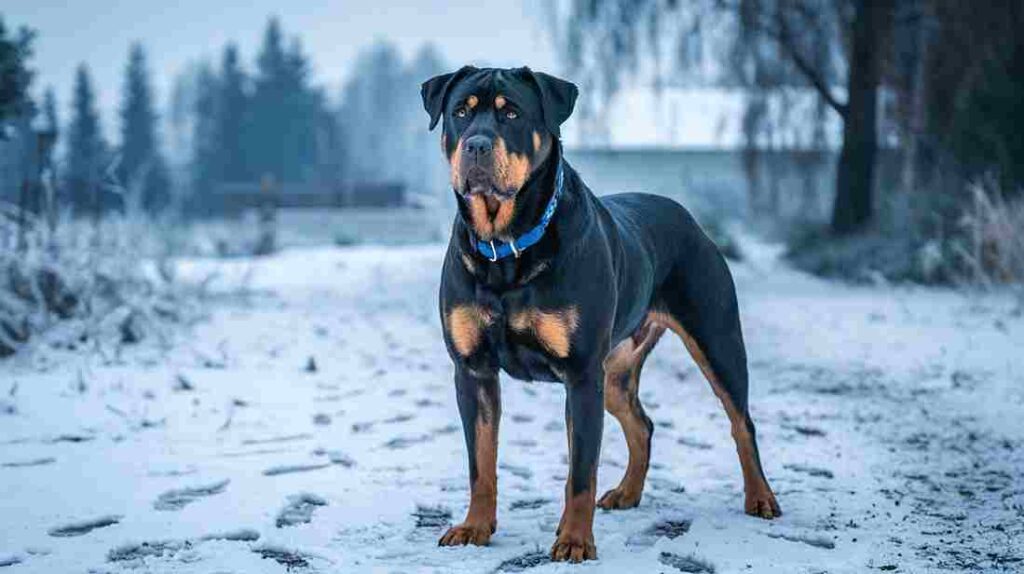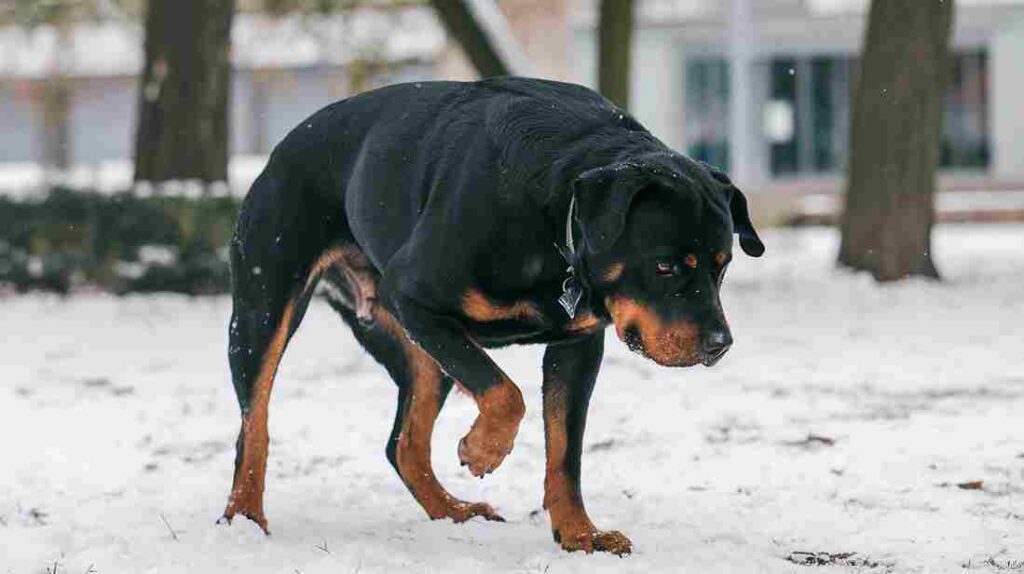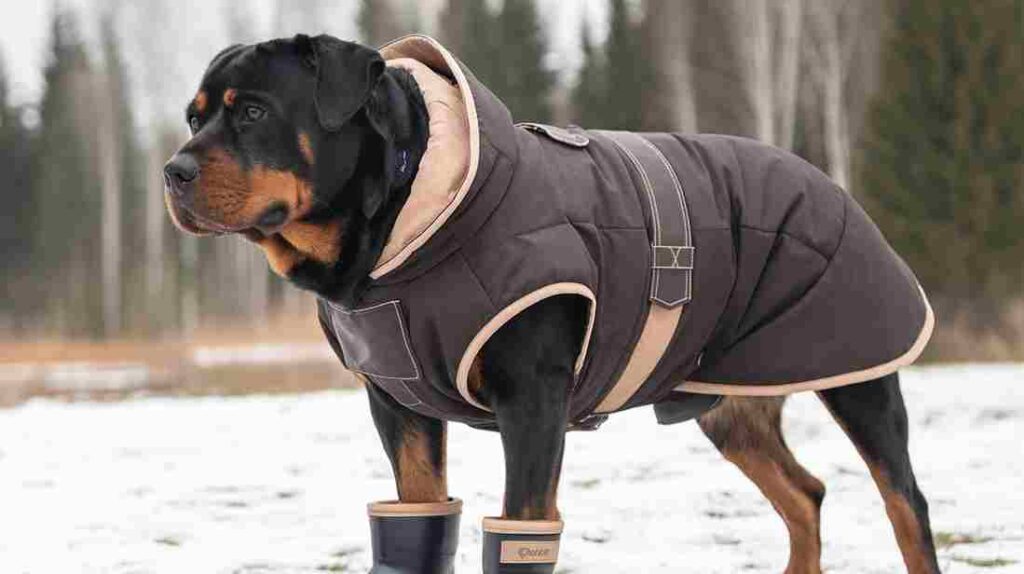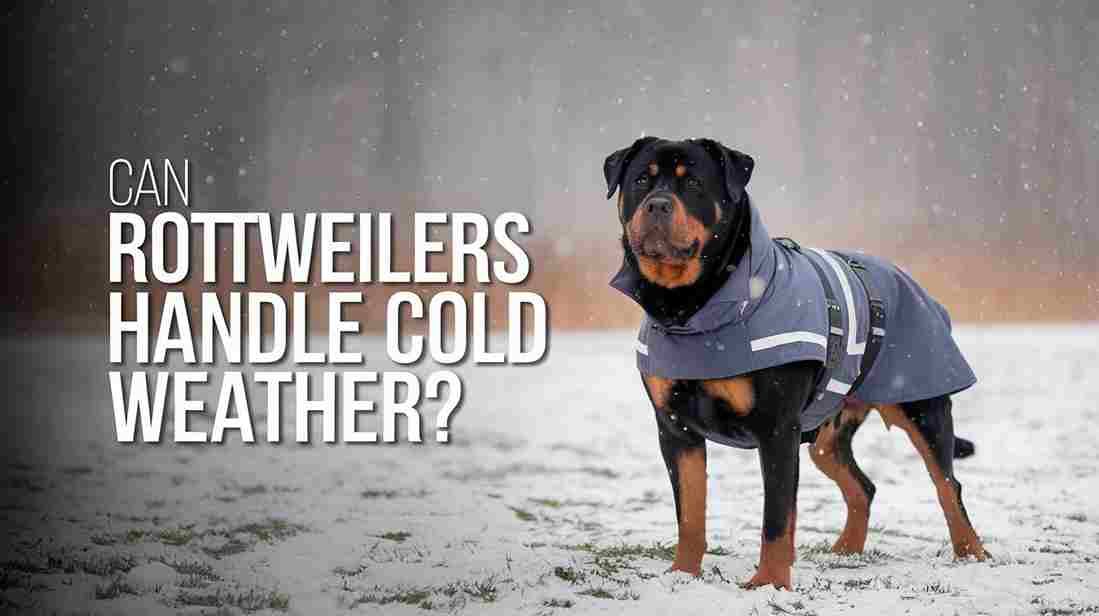Rottweiler Cold Tolerance Key Takeaways
- ✓ Cold Tolerance: Rottweilers can handle temperatures down to 40°F (4°C) comfortably, but need protection in colder conditions.
- ✓ Natural Protection: Their double coat provides good insulation but isn’t as thick as true cold-weather breeds like Huskies.
- ✓ Warning Signs: Watch for shivering, hunched posture, and reluctance to move as indicators your Rottweiler is too cold.
- ✓ Winter Protection: Use appropriate gear like coats and boots when temperatures drop below 30°F (-1°C) or during extended outdoor activities.
For the best winter gear tailored to your Rottweiler’s needs, check out our Best Winter Dog Coats for Rottweilers: Top 4 Premium Picks (2025). This guide highlights top-rated coats to ensure your furry friend stays warm and stylish all season long.
Are Rottweilers built for cold weather? As a veterinarian and long-time Rottweiler owner, I can confidently say that these powerful dogs have impressive cold tolerance, though it’s not unlimited. According to a study by the American Veterinary Medical Association, while large breeds generally handle cold better than smaller dogs, temperatures below 20°F (-6.7°C) can be dangerous for any pet.

My own Rottweiler, Max, reminded me of this reality during our first Minnesota winter together. Despite his robust double coat and German working dog heritage, I quickly learned that even these sturdy companions need proper winter care. Whether you’re a first-time Rottie owner or a seasoned enthusiast, understanding your dog’s cold tolerance limits and knowing how to protect them during harsh weather is crucial for their well-being.
In this comprehensive guide, we’ll explore everything from your Rottweiler’s natural cold resistance to essential winter care tips that will keep your four-legged friend comfortable and safe during the chilly months.
Understanding Rottweiler’s Natural Cold Resistance
As a breed originating from Rottweil, Germany, Rottweilers were developed to work in challenging weather conditions. Their robust build and genetic makeup make them naturally more cold-resistant than many other breeds. During my veterinary practice, I’ve observed that healthy adult Rottweilers typically handle temperatures down to about 40°F (4°C) without any special protection.
According to a study published in The Veterinary Journal, working breeds like Rottweilers possess a unique combination of physical characteristics that enhance their cold tolerance. Their muscular build generates significant body heat, while their double coat provides excellent insulation.
The Double Coat Advantage

Think of your Rottweiler’s double coat as a natural winter jacket system. The outer coat is like a waterproof shell, while the dense undercoat acts as an insulating layer. This combination helps them maintain their body temperature in cold conditions. However, unlike breeds like Huskies or Malamutes, Rottweilers don’t have an extremely thick undercoat, which is why their cold tolerance has limits.
Temperature Comfort Range
Based on my experience treating hundreds of Rottweilers, these dogs are most comfortable in temperatures between:
• 45-75°F (7-24°C) for active outdoor activities
• 65-75°F (18-24°C) for indoor living
• Below 40°F (4°C): Extra precautions needed
I remember treating a working Rottweiler named Bear who regularly patrolled outdoor properties in winter. His owner noticed he was more energetic and comfortable when temperatures stayed above 40°F, which aligns with the breed’s natural comfort zone. This is why it’s crucial to understand that while Rottweilers are cold-tolerant, they’re not truly cold-weather dogs like Nordic breeds.
Your Rottweiler’s individual cold tolerance can vary based on several factors:
• Age (puppies and seniors are more sensitive)
• Overall health condition
• Activity level
• Body condition (lean vs. overweight)
• Acclimatization to local weather
Understanding these natural limitations helps you make informed decisions about when your Rottweiler needs additional protection during cold weather.
Signs Your Rottweiler is Too Cold

As someone who’s treated Rottweilers for over a decade, I’ve learned that these strong dogs often try to hide their discomfort. According to a study by the AKC Canine Health Foundation, dogs can experience mild hypothermia at temperatures as high as 50°F (10°C) depending on various factors. Recognizing the early warning signs is crucial for preventing cold-related health issues.
Physical Indicators
Last winter, I treated a Rottweiler named Duke whose owner didn’t realize her pet was cold until he developed muscle stiffness. This experience taught me how subtle cold stress signals can be. Here are the key signs to watch for:
• Visible shivering or trembling – Often the first and most obvious sign
• Hunched posture with tucked tail
• Muscle stiffness or difficulty moving
• Cold ears and paw pads
• Dry, flaky skin or color changes on exposed skin
Your Rottweiler might also display behavioral changes such as:
• Excessive whining or barking
• Seeking warm places or burrowing
• Lifting paws off the ground repeatedly
• Unusual clinginess or anxiety
• Reduced interest in outdoor activities
Temperature Guidelines
Think of your Rottweiler’s cold tolerance like a thermometer with different zones. When temperatures drop below 40°F (4°C), start monitoring your dog closely. Consider these important factors:
• Wind chill effect: Can make temperatures feel 10-20 degrees colder
• Wet conditions: Dramatically reduce cold tolerance
• Duration of exposure: Short potty breaks versus extended outdoor time
• Individual factors: Age, health status, and activity level
Young puppies and senior Rottweilers are particularly vulnerable to cold. I always tell my clients to be extra cautious with these age groups, as they can’t regulate their body temperature as effectively as healthy adults. If you notice any combination of these signs, it’s time to bring your Rottweiler inside and warm them up gradually.
Remember, prevention is always better than treatment. Being attentive to these signs helps you make timely decisions about when to limit outdoor exposure or provide additional protection for your Rottweiler during cold weather.
Protecting Your Rottweiler in Cold Weather
As temperatures drop, protecting your Rottweiler becomes crucial for their health and comfort. According to a PetMD study, nearly 75% of winter-related pet emergencies could be prevented with proper preparation and protection. Just last month, I treated a Rottweiler with frostbitten paw pads because the owner wasn’t aware of the importance of proper winter gear.
Essential Winter Gear

Despite their tough appearance, Rottweilers sometimes need extra protection. Here’s what I recommend based on my clinical experience:
Dog Coats: While Rottweilers have natural insulation, they benefit from coats when: • Temperatures drop below 30°F (-1°C)
• During prolonged outdoor activities
• In wet conditions
• For elderly or sick dogs
Paw Protection: Think of your dog’s paws like your bare feet on cold pavement. They need protection from: • Ice and snow accumulation
• Salt and de-icing chemicals
• Frozen surfaces
I recommend using dog boots or paw wax for protection. My Rottweiler Max initially resisted boots, but using positive reinforcement and treating it like a game made the transition easier.
Winter Bedding: Your Rottweiler’s sleeping area should be: • Elevated from cold floors
• Away from drafts
• Equipped with warm, washable bedding
• Potentially heated for senior dogs
Cold Weather Care Tips
Winter care goes beyond just gear. Here’s how to modify your Rottweiler’s routine:
Exercise Modifications: • Shorter, more frequent exercise sessions
• Indoor activities during extreme weather
• Monitoring energy levels and breathing
• Avoiding icy conditions
Diet Adjustments: Active winter dogs might need: • Slightly increased calories for heat generation
• More frequent meals during cold snaps
• Constant access to fresh, unfrozen water
Indoor/Outdoor Management: Be strategic about outdoor time: • Schedule walks during warmer hours
• Limit exposure during extreme conditions
• Create indoor enrichment activities
• Maintain a consistent indoor temperature
Winter Grooming Needs: Proper coat care becomes crucial: • Regular brushing to maintain insulating properties
• Keeping the coat dry after outdoor activities
• Trimming snow-collecting fur between paw pads
• Monitoring skin for winter-related issues
Remember, what works for one Rottweiler might not work for another. I always tell my clients to observe their dog’s individual responses to cold and adjust protection accordingly. Your Rottweiler can’t tell you they’re cold in words, but they’ll show you through their behavior and body language.
Frequently Asked Questions About Rottweiler Cold Tolerance
Conclusion
While Rottweilers possess impressive cold tolerance, they aren’t Arctic breeds and need appropriate protection during harsh winter conditions. As both a veterinarian and Rottweiler owner, I’ve learned that successful winter care requires a balance between utilizing their natural resilience and providing additional support when needed. Understanding your individual dog’s limits and watching for signs of cold stress are crucial skills every Rottweiler owner should develop. Remember that temperatures below 40°F (4°C) warrant extra attention, and proper gear, modified routines, and consistent monitoring are essential for keeping your Rottweiler safe and comfortable. With the right preparation and care, your robust companion can safely enjoy the winter months while maintaining their active lifestyle.
While understanding your Rottweiler’s cold tolerance is crucial for their comfort and safety, it’s equally important to have a comprehensive grasp of their overall needs and characteristics. For an in-depth exploration of everything from their historical background to essential care requirements, check out our complete Rottweiler breed guide with 101 fascinating facts. This knowledge will help you provide the best care for your Rottie across all seasons and situations.







